

Walking for hypertension - Lee, LL - 2021. Blood Pressure Effects of Sodium Reduction: Dose-Response Meta-Analysis of Experimental Studies. Screening for High Blood Pressure in Children and Adolescents: US Preventive Services Task Force Recommendation Statement. Importance Prevalence of hypertension (both primary and secondary) in children and adolescents in the US ranges from 3% to 4%.
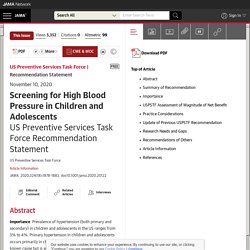
Primary hypertension in children and adolescents occurs primarily in children older than 13 years and has no known cause but is associated with several risk factors, including family history and higher body mass index. Secondary hypertension occurs primarily in younger children and is most commonly caused by genetic disorders, renal disease, endocrine disorders, or cardiovascular abnormalities. Objective To update its 2013 recommendation, the USPSTF commissioned a review of the evidence on the benefits and harms of screening, test accuracy, the effectiveness and harms of treatment, and the association between hypertension and markers of cardiovascular disease in childhood and adulthood.
Population This recommendation statement applies to children and adolescents aged 3 to 18 years not known to have hypertension or who are asymptomatic. Practice Recommendations for Diagnosis and Treatment of the Most Common Forms of Secondary Hypertension. 1.Williams B, Mancia G, Spiering W, Agabiti Rosei E, Azizi M, Burnier M, et al. 2018 ESC/ESH guidelines for the management of arterial hypertension.
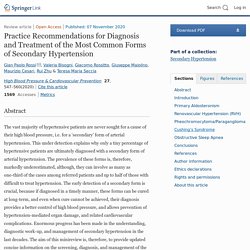
Eur Heart J. 2018;39:3021–104.PubMed Google Scholar 2.Chiong JR, Aronow WS, Khan IA, Nair CK, Vijayaraghavan K, Dart RA, et al. Secondary hypertension: current diagnosis and treatment. Int J Cardiol. 2008;124:6–21.PubMed Google Scholar 3.Azizi M, Sapoval M, Gosse P, Monge M, Bobrie G, Delsart P, et al. Optimum and stepped care standardised antihypertensive treatment with or without renal denervation for resistant hypertension (DENERHTN): a multicentre, open-label, randomised controlled trial. Nonpharmacologic Interventions for Reducing Blood Pressure in Adults With Prehypertension to Established Hypertension. 2020 International Society of Hypertension global hypertensi... : Journal of Hypertension.
Table of Contents 8.1 Lifestyle modification 989 8.2 Pharmacological treatment 989 8.3 Adherence to antihypertensive treatment 989 10.1 Resistant hypertension 994 10.2 Secondary hypertension 994 10.3 Hypertension in pregnancy 994 10.4 Hypertensive emergencies 996 10.5 Ethnicity, race and hypertension 997 Context and purpose of this guideline Statement of remit: To align with its mission to reduce the global burden of raised blood pressure (BP), the International Society of Hypertension (ISH) has developed worldwide practice guidelines for the management of hypertension in adults, aged 18 years and older.
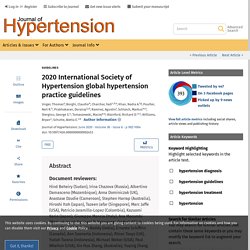
Herein optimal care refers to evidence-based standard-of-care articulated in recent guidelines [1,2] and summarized here, whereas essential standards recognize that optimal standards would not always be possible. In the Guidelines, differentiation between optimal and essential standards were not always possible, and were made in sections where it was most practical and sensible. Medical history. 2020 International Society of Hypertension Global Hypertension Practice Guidelines. Effect of salt substitution on community-wide blood pressure and hypertension incidence. The study protocol and methods have been described previously29, and a summary is provided below.
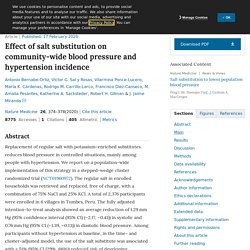
The CONSORT statement for randomized cluster trials30 and recent literature on reporting results of stepped-wedge cluster trials31,32 were utilized. Study design A stepped-wedge, cluster, randomized controlled trial was conducted, in which the six participating villages (clusters) crossed over from the control to the intervention phase during the study33. The order of switchover for each cluster was determined by randomization, and all villages received the salt substitute by the end of the study. The structure of the stepped wedge is provided in Fig. 3, where the intervention periods (village implementation phases, shown in gray) lasted 4 months, and blood pressure measurements were made every 5 months after the baseline period.
Study setting Participants and recruitment Potentially eligible subjects were identified from the most updated census in the area (2010, updated in 2014). Ethics. Hypertension in adults: diagnosis and management. 1.1 Measuring blood pressure 1.1.1 Ensure that healthcare professionals taking blood pressure measurements have adequate initial training and periodic review of their performance. [2004] 1.1.2 Because automated devices may not measure blood pressure accurately if there is pulse irregularity (for example, due to atrial fibrillation), palpate the radial or brachial pulse before measuring blood pressure.
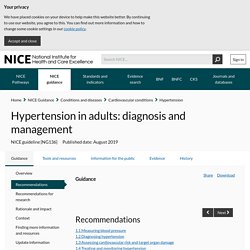
If pulse irregularity is present, measure blood pressure manually using direct auscultation over the brachial artery. [2011] 1.1.3 Healthcare providers must ensure that devices for measuring blood pressure are properly validated[], maintained and regularly recalibrated according to manufacturers' instructions. [2004] Hypertension Guidelines from JAMA Network. Measurement of Blood Pressure in Humans: A Scientific Statement From the American Heart Association. אבחון וטיפול ביתר לחץ דם במבוגרים וילדים 2019.